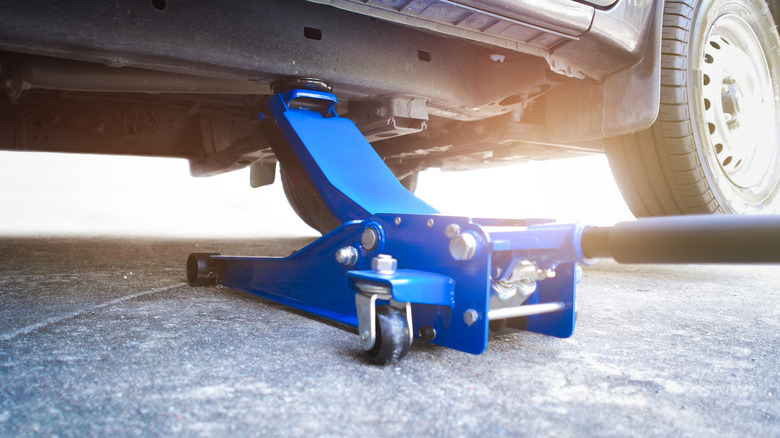Bottle Jack Vs. Floor Jack: What's The Difference?
There's no denying that mechanics are hugely helpful professionals in modern society. They're able to get some of the most complicated and time-consuming car repair jobs done in no time, more often than not getting them done right the first time. Still, even with a local mechanic, it's still in one's best interest to learn about their car and some of the work they can do on it. In that vein, understanding and purchasing the tools of the trade is crucial, too. Alongside some specialty tools that every home mechanic should get ASAP, there are those that are essential.
One of the most useful pieces of car repair equipment one can keep around is a solid jack. This way, if you end up stranded with a flat tire and need to swap it out, or you want to try your hand at a repair on the underside of your ride, you can raise the vehicle up with ease. This may make it sound like you can just grab any old jack and be on your way, but that's not quite the case. There are around six different automotive jacks out there for different use cases, with two common varieties behind the bottle jack and the floor jack. Both are used to get an automobile off the ground, but they're not the same tool.
Bottle and floor jacks differ in a few key areas
First and foremost, bottle and floor jacks look quite different. As the name implies, the bottle jack looks like a bottle, standing vertically with a slot to insert the pump handle, and is on the smaller side size-wise. When pumped up, the top of the "bottle" portion raises up to lift the vehicle. A floor jack, on the other hand, is longer, rectangular, and horizontal, with a pump handle that raises a small platform on the other end to lift the vehicle. It is also typically on wheels, so it can be rolled under a car, while a bottle jack is generally stationary and doesn't have wheels.
Their specific uses drive them further apart. A bottle jack, being a vertical tool, is better suited for vehicles with increased ground clearance, like trucks. For the vehicles they can lift up, they can do so to a higher elevation than a floor jack, albeit with significantly less stability. Conversely, the more horizontal floor jack can work well on rides lower to the ground, and their wheels make it easier to slide them under and position. They may not lift as much as bottle jacks, but they are more stable and a superior choice on uneven ground.
It's also worth mentioning that bottle jacks are relatively light and compact, making them easier to transport than their heavier, larger floor jack counterparts. Between the two, a bottle jack is typically a more affordable option at between $20 and $60 for a standard model than the floor jack, which can cost anywhere from $60 to well over $100.
Which jack is the right one for you?
With the differences between bottle and floor jacks in mind, it becomes easier to figure out which is best for your specific situation. A bottle jack is best if you're looking for a compact and lighter yet strong jack to toss in your trunk, be it for emergencies or as a precaution on a road trip. If your vehicle has higher clearance underneath, it'll serve you just fine. It's also significantly cheaper, so it's a more budget-friendly option.
On the other hand, a floor jack is good for lower-clearance cars or situations where stability is important, but strength isn't as much of a concern. Due to their comparatively heavier weight and larger size, these are perfect for keeping around the garage for random repairs or if you're a regular at-home mechanic. In the event you have some extra funds to spare, a floor jack is excellent to have for everything from oil changes to tire replacements.
Regardless of how handy you are when it comes to cars and trucks, it's important to know your jacks (and jack stands, for that matter), which aren't always wise to cheap out on. This way, if you ever have to decide between the bottle and floor varieties, you know what you're getting into before making a purchase and getting to work.


